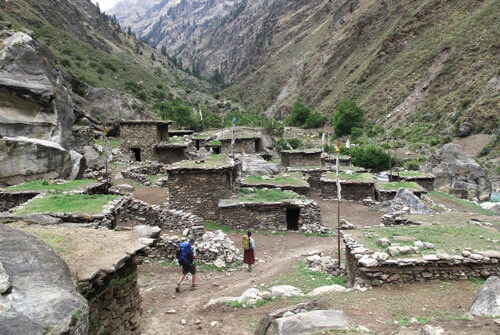Prevention of High Altitude Sickness in Nepal
High Altitude Sickness, also known as Acute Mountain Sickness (AMS), is a common condition that can occur when you trek at high altitudes too quickly. Many travelers who come to Nepal for trekking or climbing have encountered this hazardous mountain illness.
Like for example, at Everest Base Camp Trek, many trekkers and mountaineers encounter this fatal illness and don't attain their desired objective. As of now, there has been too much talk and education in regard to altitude sickness. Yet it is very tragic to see mountain sickness deaths in the Nepal mountains. This is the reason why it has been very crucial to know about the prevention of high-altitude sickness in Nepal.
This condition is caused by the body's inability to adjust quickly enough to the lower oxygen levels and decreased air pressure found at higher altitudes. At high altitudes, the air pressure is lower, which means that there is less oxygen available in the air. As a result, the body compensates by increasing the breathing rate and heart rate to deliver more oxygen to the tissues.
However, this increased demand for oxygen can lead to experiencing high altitude pressure, which can cause various symptoms such as headache, fatigue, and shortness of breath. It can affect anyone, regardless of age or fitness level.
Altitude Sickness History:
The first recorded case of altitude sickness is difficult to determine with certainty, as it is likely that people have experienced symptoms of altitude sickness throughout history. However, there are some historical accounts that suggest that altitude sickness was recognized and described as early as the 16th century.
For example, in 1589, a Swiss physician named Felix Platter described the symptoms of altitude sickness in his diary after climbing a mountain. Similarly, in the early 17th century, the Spanish physician and botanist Francisco Hernandez wrote about the symptoms of altitude sickness that he observed in his travels to the mountains of Mexico.
It is also believed that in 1817, when the Argentinian Army crossed the Andes Mountains, which was over 5000m, to free Chile from the Spanish Empire, many of their soldiers actually died due to Altitude Sickness. Altitude Sickness or AMS was then mistakenly perceived as the flu and was treated accordingly. This unawareness indeed took the lives of many during that period of mountain warfare.
However, it is important to note that Altitude Sickness was not well understood or studied until relatively recently. It was not until the 19th and 20th centuries that scientists began to systematically study the effects of high altitude on the human body and to develop treatments for altitude sickness.
The symptoms of high altitude sickness (AMS) can range from mild to severe and can include:
- Headache
- Nausea and vomiting
- Dizziness or lightheadedness
- Shortness of breath
- Fatigue
- Loss of appetite
- Difficulty sleeping
- Headache: This is the most common symptom of altitude sickness. It can range from mild to severe and can be accompanied by nausea and vomiting.
- Dizziness and lightheadedness: As you ascend to higher altitudes, the amount of oxygen in the air decreases, which can cause you to feel dizzy and lightheaded.
- Fatigue: Your body has to work harder to get the same amount of oxygen at high altitudes, which can make you feel tired and lethargic.
- Shortness of breath: The reduced amount of oxygen in the air can make it difficult to breathe, particularly when you exert yourself.
- Loss of appetite: You may find that you don't feel hungry, which can make it difficult to eat enough to keep your energy levels up.
- Insomnia: It can be difficult to sleep at high altitudes due to the decreased oxygen levels and the physical discomfort caused by altitude sickness.
- Swelling: High altitude can cause swelling in your hands, feet, and face.
The risk of altitude sickness increases as you ascend to higher altitudes more quickly, so it's important to acclimate yourself gradually and seek medical attention if you experience any symptoms of altitude sickness.
If left untreated, AMS or high altitude sickness can progress to more serious conditions such as high altitude cerebral edema (HACE) or high altitude pulmonary edema (HAPE). These conditions can be life-threatening.
- HIGH ALTITUDE PULMONARY EDEMA (HAPE) - In HAPE, the reduced oxygen levels can cause fluid to leak from the blood vessels in the lungs into the air sacs, which can make it difficult to breathe. The symptoms of HAPE can develop rapidly and can include cough, chest tightness, rapid heartbeat, and a bluish color to the skin or lips.
If left untreated, HAPE can lead to severe respiratory distress, heart failure, and even death. Treatment typically involves immediate descent to a lower altitude, oxygen therapy, and medications to help reduce fluid buildup in the lungs. It is important for individuals planning to travel to high altitudes to acclimatize slowly and to seek medical attention if they experience any symptoms of HAPE or other altitude-related illnesses.
- HIGH ALTITUDE CEREBRAL EDEMA (HACE) – HACE is a potentially life-threatening condition that can occur at high altitudes, typically above 8,000 feet (2,400 meters). HACE is a severe form of altitude sickness that occurs when there is an accumulation of fluid in the brain due to reduced atmospheric pressure and lower oxygen levels at high altitudes.
Symptoms of HACE can include severe headache, confusion, loss of coordination, vomiting, and coma. If HACE is left untreated, it can be very disastrous.
Why is Acclimatization Important?
Acclimatization refers to the process of adjusting to the reduced oxygen levels and other environmental factors that occur at higher elevations. It is important because the human body is not adapted to function at high altitudes where there is less oxygen available to breathe.
When you ascend to higher altitudes, the air pressure and oxygen levels decrease. This can cause several physiological changes in your body, such as an increase in heart and respiratory rates, a decrease in appetite, and an increase in urine output. These changes are part of the body's attempt to adapt to the lower oxygen levels and maintain an adequate oxygen supply to vital organs.
However, these changes take time to occur, and acclimatization allows your body to gradually adjust to the new environment. Without proper acclimatization, you are at risk of developing altitude sickness, which can be lethal. Therefore, it is essential to acclimatize properly by spending time at intermediate altitudes.
It is very crucial to increase elevation gradually, stay well-hydrated, and avoid alcohol and smoking. This allows your body to adapt to the lower oxygen levels and reduces the risk of altitude sickness.
Here are some tips on the prevention of high-altitude sickness in Nepal:
- Gradual ascent: Ascend slowly to give your body time to acclimate to the altitude. Avoid climbing more than 300-500 meters per day once you reach 2500 meters above sea level.
- Stay hydrated: Drink plenty of fluids to avoid dehydration, which can worsen altitude sickness.
- Avoid alcohol and caffeine: These substances can cause dehydration and may exacerbate altitude sickness symptoms.
- Proper Acclimatization: If possible, spend a few days at an intermediate altitude to allow your body to adjust to the reduced oxygen levels.
- Medications:Medications like Acetazolamide (DIAMOX) or Dexamethasone can help prevent altitude sickness. However, these should be taken under medical supervision. 250mg of Acetazolamide can be taken every day for prevention. However, it is to be noted that Acetazolamide does not cure AMS once you get it.
- Proper nutrition: Eat a balanced diet with sufficient calories to help your body cope with the high altitude.
- Recognize the symptoms: Be aware of the signs and symptoms of altitude sickness so you can take action before the condition worsens.
If you experience severe symptoms of altitude sickness, such as confusion, difficulty breathing, or chest tightness, seek medical attention immediately. In some cases, altitude sickness can be life-threatening.
CONCLUSION:
If you are trekking in Nepal and begin to experience symptoms of AMS, it is important to take action immediately. The first step is to descend to a lower altitude, as this will help your body acclimatize to the reduced oxygen levels. You should also rest and drink plenty of fluids to help alleviate symptoms. Oxygen therapy and medications such as acetazolamide may also be prescribed to treat AMS.
In more severe cases, medication such as acetazolamide may be recommended by a medical professional. It is essential to have a plan in place for dealing with AMS before you begin your trek, including having access to medical advice and knowing how to recognize and respond to symptoms.
If you are concerned about AMS or any other medical condition while trekking in Nepal, it is essential to seek medical advice from a qualified healthcare professional.
Finally, all trips with Nepal Pyramids are designed with sufficient grounds for acclimatization. Besides, all our Group Leaders are medically trained to deal with all mountain ailments, including Altitude Sickness and other Emergency issues. On all our trips, we provide a comprehensive medical kit that includes all medicines, including antibiotics and Diamox. We also provide Oxygen Camber Bag (PAC) OR Oxygen cylinders on all our high-altitude trips for safety concerns.
People also search for:





